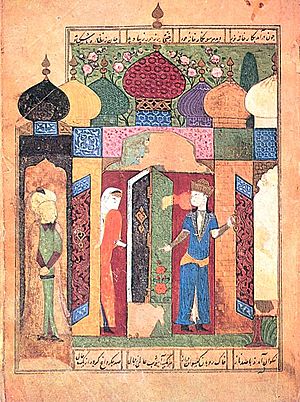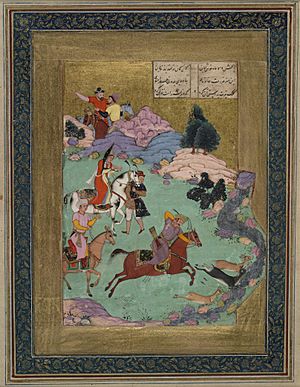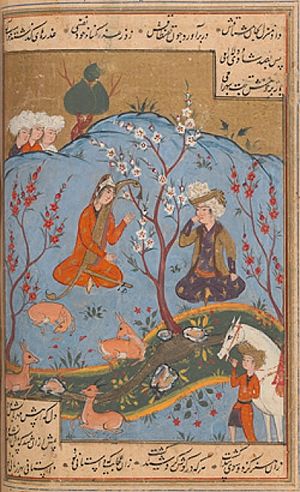Hasht-Bihisht (poem) facts for kids
Hasht-Bihisht (which means "The Eight Paradises") is a very famous poem. It was written by a poet named Amir Khusrow around the year 1302 AD. This poem is based on an older story called Haft Paykar by Nizami, written around 1197 AD. That story, in turn, got its ideas from an even older epic poem, the Shahnameh, written by Firdausi around 1010 AD.
Like Nizami's Haft Paykar, Khusrow's Hasht-Bihisht uses a legend about a king named Bahram V Gur. This king's story acts like a main frame, holding together many smaller tales. It's similar to how stories are told in One Thousand and One Nights. In Hasht-Bihisht, seven princesses tell different folktales. A cool fact is that Khusrow seems to be the first writer to include the characters from the story of The Three Princes of Serendip. He also added their famous tale about a stolen camel.
The eight "paradises" in the poem are connected to the Islamic idea of Heaven. Heaven is often described as having eight gates or eight special areas. Each of these areas is decorated with a unique precious stone or material. Seven of these eight paradises are actually beautiful pavilions. King Bahram had these built for his "storytelling therapy." There is also a link between the poem's "eight paradises" and real-life architectural designs and garden layouts.
Contents
The Story of Hasht-Bihisht
The poem begins by telling the story of King Bahram and a woman named Dilaram.
Later in the story, King Bahram builds seven different-colored domed pavilions. These are located within his palace grounds. Inside each pavilion waits a princess from a different part of the world. King Bahram Gur visits a different princess on each day of the week. Each princess then tells him a unique story:
- Saturday – the Black Pavilion – the Indian Princess tells her tale. This is where the story of the Three Princes of Serendip is found.
- Sunday – the Yellow Pavilion – the Princess from Nimruz shares her story.
- Monday – the Green Pavilion – the Slav Princess tells her adventure.
- Tuesday – the Red Pavilion – the Tatar Princess shares her narrative.
- Wednesday – the Violet Pavilion – the Princess from Rum tells her story.
- Thursday – the Brown Pavilion – the Arabian Princess shares her tale.
- Friday – the White Pavilion – the Princess from Khwarezm tells her story.
Copies of the Poem
The Hasht-Bihisht poem, and the entire collection of poems called the Khamsah, was very popular for centuries after Khusrow died. People loved it not only in India but also in Iran and the Ottoman Empire. Because it was so loved, many copies were made. These copies were often beautifully illustrated, almost as much as Nizami's Khamsah, starting from the early 1400s.
Walters Art Museum Manuscript W.623
One beautiful copy of the poem is part of a Khamsah from 1609 CE. It was made in Safavid Iran. All the words are written in black nastaʿlīq script, which is a special style of writing. The headings for each chapter are written in red.
Walters Art Museum Manuscript W.624
Another illustrated copy of the poem was likely made in Lahore in the late 1500s CE. This copy is linked to the great ruler Akbar (who ruled from 1556 to 1605 CE).
This manuscript was written by a very skilled writer named Muhammad Husayn al-Kashmiri. He was known as "Zarrin Qalam," which means "golden pen." This shows how amazing his writing was! The manuscript also lists the names of many painters who worked on it. These include Lal, Manuhar, Sanwalah, Farrukh, Aliquli, Dharamdas, Narsing, Jagannath, Miskina, Mukund, and Surdas Gujarati. The artists who added the beautiful decorations were Husayn Naqqash, Mansur Naqqash, Khvajah Jan Shirazi, and Lutf Allah Muzahhib.
Images for kids
-
The Story of the Princess of the Blue Pavilion, Metropolitan Museum of Art
See also
 In Spanish: Hasht-Bihisht (poema) para niños
In Spanish: Hasht-Bihisht (poema) para niños












